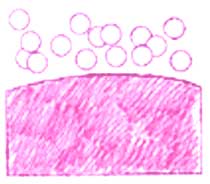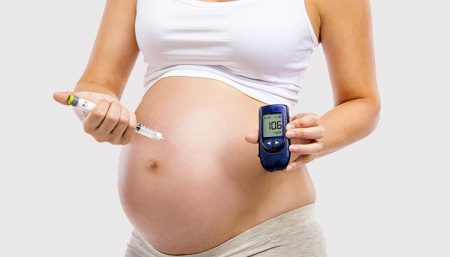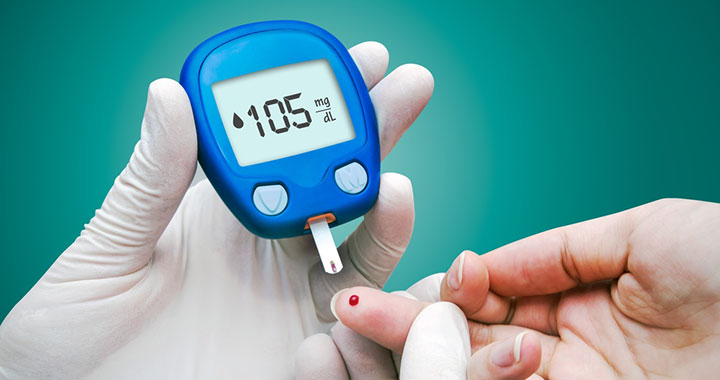
Diabetes is a disease that affects the body’s ability to produce and respond to insulin, a hormone that allows blood glucose (blood sugar) to enter the cells of the body and be used for energy. Diabetes Mellitus is a condition characterized by an excess of glucose (sugar) in the blood. This happens because the body is not producing enough insulin, the hormone it needs to break down sugar. Normally after eating foods containing sugar, the blood sugar level rises, whereupon the pancreas release insulin to help the cells absorb and use the sugar. The sugar is present, but the body cannot use it. . The most effective way for the body to get rid of unwanted sugar is by producing urine, a phenomena common among diabetics.
|
CELL OF A HEALTHY WOMEN |
Insulin Allows Glucose To Enter Cells
|
Abnormally high quantities of sugar in blood can cause potentially serious problems. Hyperglycemia may result if the blood sugar levels continually run high. This can affect several tissues in the body, especially the eyes, kidneys and blood vessels spreading to arms and legs. But, once the sugar level is corrected and well controlled, diabetic women can lead normal lives.

DIFFERENT FORM OF DIABETES
Diabetes fall into 3 medication categories:-
* Those who require insulin injections:-
In some people the pancreas is incapable of producing any insulin, which may be diagnosed in childhood or may appear later, under the age of forty. This is referred to as insulin-dependent diabetes mellitus (IDDM).
|
CELL OF WOMEN WITH TYPE-I DIABETES |
Lack Of Insulin prevents Glucose From entering The Spine
|
* In other cases, the pancreas can produce some insulin, but not sufficient for the body needs. This type, is called Non-Insulin dependent diabetes Mellitus (NIDDM), this is more common in older women, especially those who are overweight.
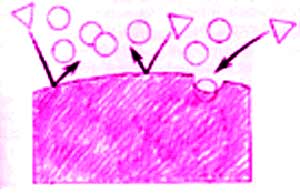
CELL OF WOMEN WITH TYPE-II DIABETES |
Cell’s Resistance To Insulin prevents Adequate Glucose From Entering
|
* In few cases the pancreas needs a ‘kick start’ from tablets that stimulate the pancreas into producing more insulin whereas some may have to monitor their food intake and activity levels and balance it with the amount of insulin in their body.
The disturbed metabolism in diabetes brings about the following characteristic symptoms :-

* Polyuria or frequent urination and an abnormally large volume of urine, results when glucose passes through the kidneys in excessive amounts.
* Polydipsia – or excessive thirst is explained by the great loss of body fluids in the urine and the need for replacement in the tissues.
* Polyphagia or increased appetite, results from the failure to utilize the food for nourishment of the body cells.
* Dehydration :- is occasioned by the excessive urinary output and the failure to balance it by water intake.
* General weakness and loss of weight follow the inability to use foods and the subsequent breakdown of body tissues.
* Decreased resistance to infection :- Especially staphylococal infection and tuberculosis, becomes apparent in untreated and poorly regulated cases of diabetes
Decreased ability of the tissue to heal, occurs with a high blood sugar and poor fluid balance.
* Degenerative changes:- Such as peripheral neuritis, Retinitis, Atherosclerosis with disease of coronary arteries and vascular changes in the kidneys is evident in advanced cases, especially those which have been poorly controlled.
* Ketosis or acidosis is the accumulation of lower fatty acids in the blood and may ultimately lead to coma and even death.
* Diabetes increases the hazards of pregnant women because of dangers of glycogen depletion, hypoglycemia, acidosis, and injection.
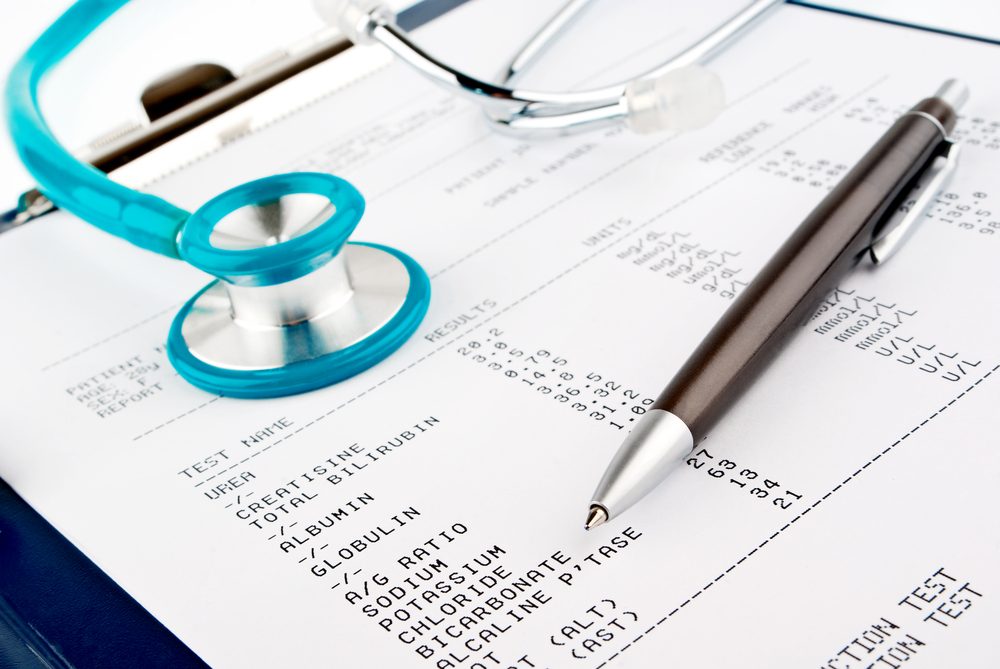
Once a diagnosis is made on the basis of symptoms and treatment started, the patient is taught to determine the urinary excretion of sugar and of ketones so that the women has some indication of diabetes.
GLYCOSURIA or the occurrence of sugar in urine is regarded as an evidence of diabetes until proved otherwise.
HYPERGLYCEMIA may be detected by determination of concentration of sugar after fast of 12 hrs. A fasting sugar of more than 140 mg/100ml is suggestive of diabetes.
KETONURIA :- or the excretion of ketones, occurs when fatty acids are incompletely oxidized in the body. This can be detected through a simple routine test.
The glucose tolerance test – is the measure of the ability of the body to utilize a known amount of glucose. Under this condition a normal women shows a rise of blood sugar after 1/2 hr after ingestion of sugar, but the blood sugar value returns to normal in 2 hrs. If the blood sugar rises above 140-150 mg per 100ml and fails to return to normal fasting levels within 3 hrs, diabetes is presumed to be present.
(a) Diet Management
(b) Exercise
(c) Medication
DIETARY MANAGEMENT
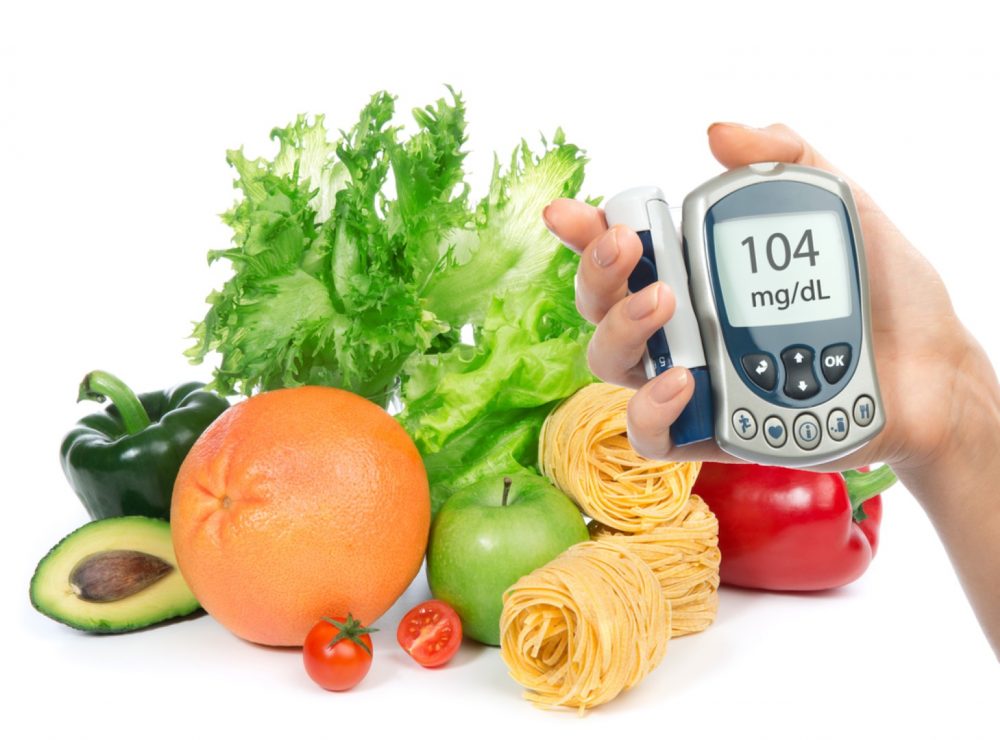
HEALTHY EATING FOR DIABETICS
Your daily eating pattern should consist of about three regular small meals, and plenty of water. To summarize, the meals should contain: high-fibre carbohydrate, fresh vegetables and fruit, a portion of lean protein, a small amount of dairy produce. The ‘watch points’, particularly important for diabetics, are : saturated/animal fats, sugary, low-fiber foods and alcohol.
YOU NEED A REGULAR AMOUNT OF HIGH-FIBRE CARBOHYDRATE
For a diabetic, it is particularly important to choose high-fiber versions of carbohydrate foods, such as whole meal bread or brown rice. Physiologically this is because the thick plant cell walls in these foods take longer to break down, allowing a steady release of sugar into the blood. This makes it easier to keep the blood sugar level within the desirable range. Try to keep roughly the same amount of carbohydrate in each of your meal. For both insulin dependent and non-insulin-dependent diabetics you should work out how much carbohydrate you need, firstly to maintain good sugar levels and energy levels and secondly to maintain your weight at the level at which you feel comfortable.
If you positively don’t like the high-fiber versions of some foods, you should regulate your portion size of the lower fiber food and boost the fiber content of your meals with vegetables, pulses of fruits.
AIM TO HAVE FIVE PORTIONS OF VEGETABLES ON FRUITS EVERY DAY :-
A diet high in fruits and vegetables not only helps you regulate your blood sugar levels, it also has other advantages.
*It can help to prevent cholesterol from depositing in the blood vessels, which reduces the risk of heart disease and strokes.
*It can reduce the risk of certain cancers.
*It can reduce the signs of ageing. Research is still in its early stages, but it is apparent that a healthy well-balanced diet that is rich in vitamins C and E (found in vegetables, fruits, grains, nuts and seeds, as well as in vegetables, oil and eggs ) helps keep the body and especially the skin, looking and feeling younger.
Fruits do contain sugar, but the fiber in the fruit helps to slow down the release of the sugar. It’s therefore good to get into the habit of having a portion of fruit after and in between meals. A portion would be a whole apple or a banana, about ten grapes or fresh strawberries. Tinned or frozen fruits can be fine, as long as they are stored in their natural juice rather than sugary syrups.
Aim to have at least two helpings of vegetables every day. This could be a lunchtime salad or even a sandwich packed with salad vegetables, a bowl of vegetable soup, a selection of vegetables or side salad with your evening meal. Remember that potatoes should be considered as part of your high-fiber carbohydrate intake.
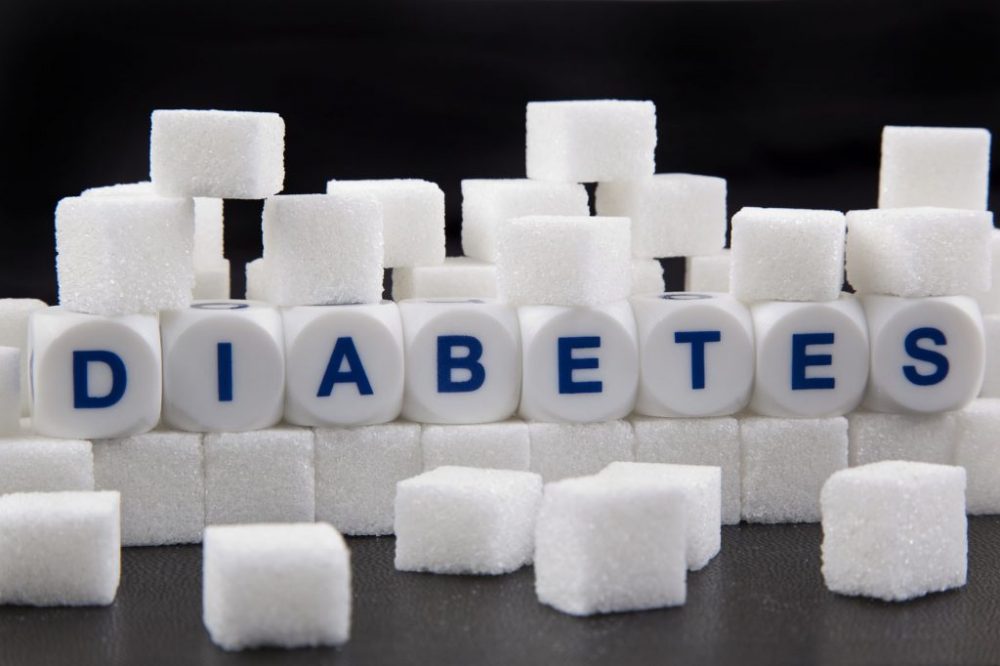
* HAVE A PORTION OF LEAN PROTEIN AT YOUR LUNCH AND EVENING MEALS
Protein is needed to build healthy body tissues, choose a lean protein, not highly fatty meat or processed foods such as cheap sausage. Fish is a good choice two or three times a week. Instead of cooking in fat, try marinating protein foods in wine, with herbs and spice. Vegetarians can get their protein from eggs, beans, lentils and other sources.
* YOU NEED A SMALL BUT REGULAR INTAKE OF DAIRY PRODUCTS
Diary products are an extremely valuable source of calcium, which is an important mineral for all women . Dairy products don’t adversely affect blood sugar levels, unless they are also full of added sugar, for example ice cream or milk chocolate.
‘Live’ yogurts containing acidophilus and bifidus cultures provide not only calcium but also beneficial bacteria.

* DRINK PLENTY OF WATER DURING THE DAY
You should try to have at least two liters (about four pints, or eight or ten large tumblers) of water a day. This will help to excrete excess sugar from your body and also help the fiber in your diet to perform its blood sugar regulatory duties. This amount of water also enables your kidneys and other organs (including your skin) to stay healthy.
* AVOID FATTY FOODS
Diabetic women are more prone to developing heart disease because their blood vessels contain more sugar than those of non-diabetic women, causing the blood cells to become more’ sticky’ and therefore more likely to pick up circulating fats and cause obstructions. Try to keep your intake of all fats to a minimum, particularly the saturated (mainly animal-based) fats.
* RESTRICT YOUR INTAKE OF SUGARY LOW-FIBER FOODS
This causes your blood sugar level to rise very high, especially if they are eaten on an empty stomach. As a general rule this is not advisable, as it makes it very difficult to keep your blood sugar level within the normal range. Sugary foods can be enjoyed on occasions, but it is important to incorporate them within your meals, and in small amounts.

EXERCISE :-
*Get through a medical examination before you start an exercise program your doctor should check your:-
- Blood Pressure
- Blood fat levels
- Glycated hemoglobin levels
- Kidney function
- Eyes
- Heart and nervous system
- Feet
* You should include some aerobic exercise in your daily routine. Aim to take at least a good brisk walk, ideally lasting for 20 min, everyday. In case you have lost feeling in your feet, swimming may be a better alternative.
* Always warm-up, stretch and cool down at the beginning and towards the end of exercise program.
* Include weight training in your fitness program, by working out with light weights. This will enhance your body strength, focus on an exercise program that feature 3 repetitions with light, hand held weights.
* Check your blood sugar before, during and after exercise, to see that your blood sugar level is stable or dropping. If your blood sugar level starts to fall, stop and have a snack.
* Time your exercise according to your meals and insulin. Ask four dietician on tips about snacking and exercise, to achieve weight loss without causing low blood sugar levels.
Exercise with diabetes does demand few extra safety steps. Once you get going on a regular fitness program, you will find that you need less insulin or lower doses of diabetic pills. Make exercise a part of your routine, and you will see that the rewards of exercise are well worth a little extra effort. For more evidence on benefits of exercise for diabetics, click here as reported by lifeclinic.

MEDICATION
Many people who have type II diabetes do not need to take medication if they carefully follow their diet, weight loss, and exercise program. However, if these measures do not keep your level of glucose in the normal range, your doctor may prescribe hypoglycemic medication (in pills), which lowers your blood glucose level by stimulating your pancreas to make more insulin. The insulin enables your cells to take in more glucose. Some people with type II diabetes eventually have to take insulin injections every day to control their glucose level. Side effects of Hypoglycemic medications include hypoglycemia (low blood sugar) , which can result if you take too much of the drug or loss of appetite , skin rashes or itching . Consult your doctor right away if you have any kind of reaction to the medication.
In case of class I diabetes your doctor will advice you to give yourself injection of insulin . Insulin is not the cure for diabetes, but it controls the level of glucose in your blood , prevents complications from the disease and allows you to live a normal and active life .Besides your doctor will tell you how often you should test your glucose and take insulin injections .
A recent study (Sept 23,2002) reported reasons for undesirable side effect of weight gain in case of patients on the drug thiazolidinediones (TZDs). It was indicated that these drugs often cause weight gain, however, because they induce fat cells to divide and produce more fat cells. New fat cells are small to begin with and are very active metabolically, sucking up free fatty acids and storing them as triglycerides. This helps reduce HbA1c in the first few months. Over time, these patients lay down more and more fat cells which, when they fill up with triglycerides, result in steady and progressive weight gain. Consult your physician, if you are on glitazones.
If you have Diabetes , always wear an identifying bracelet or necklace , or carry a card in your purse to alert doctors or other emergency health care personnel of your Diabetes in case of becoming unconscious.
Disclaimer
The Content is not intended to be a substitute for professional medical advice, diagnosis, or treatment. Always seek the advice of your physician or other qualified health provider with any questions you may have regarding a medical condition.



